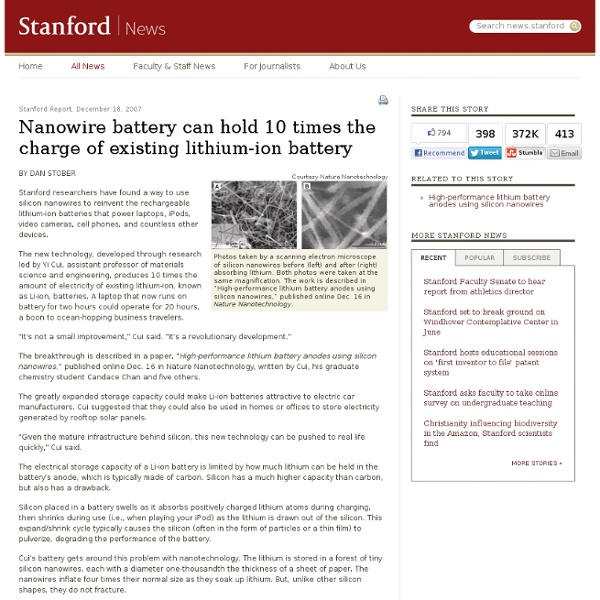Nanowire battery can hold 10 times the charge of existing lithium-ion battery

3D holograms enter the fourth dimension - tech - 03 November 2010
Video: Holograms go 4D Holography has just gained a fourth dimension, bringing the prospect of Star Wars-style holographic telepresence into the real world. Ever since Emmett Leith and Juris Upatnieks made the first laser holograms in 1963, holography has been the future of three-dimensional imaging. Once created, a hologram can be illuminated to create a pattern of light waves that replicates the light reflected by the original object, generating a 3D image without the need for special glasses. As such, holography seems an ideal medium for three-dimensional telepresence, like the famous "hologram" of Princess Leia in the first Star Wars movie. During its 2008 presidential election night coverage, CNN's coverage used what appeared to be holographic technology, with anchor Wolf Blitzer talking face-to-face with a virtual 3D correspondent, Jessica Yellin – but the impressive visuals were added to the camera feed rather than being projected live onto the studio floor. Plastic pictures
Racetrack memory will make computers 100,000 times faster - Tucson Technology
Researchers at the Laboratory of Nanomagnetism and Spin Dynamics are working on a form of memory that will work 100,000 times faster than today’s hard drives. Not only are they faster, they are also far more efficient. Current computers take an average of 2-3 minutes to transfer information from the hard disk to the RAM. This new technology would allow for computers to boot up instantly and retrieve data 100,000 times more rapidly. In addition to lightning fast speeds it is also extremely efficient. EPFL explains how it works: Like the tried and true VHS videocassette, the proposed solution involves data recorded on magnetic tape. EPFL is currently working with IBM to create a prototype. For more info: EPFL
1,000 Core CPU Achieved: Your Future Desktop Will Be a Supercomputer
Scientists at the University of Massachusetts Lowell laugh in the face of Intel's weedy handful of cores in its new CPU lineup: They've just squeezed over a thousand processor cores onto a single chip. We've heard a lot about the potential for future desktop-sized supercomputers, but more than anything else this research proves that in the not-too-distant future it's likely to be a reality. Interestingly enough, there's also a green angle to this idea: FPGA chips can be more power efficient than their competitors, and if less computer time is needed to process complex tasks, then the overall power consumption of computers using the tech could be impressively low. The advance was made by Dr.
Related:
Related:



